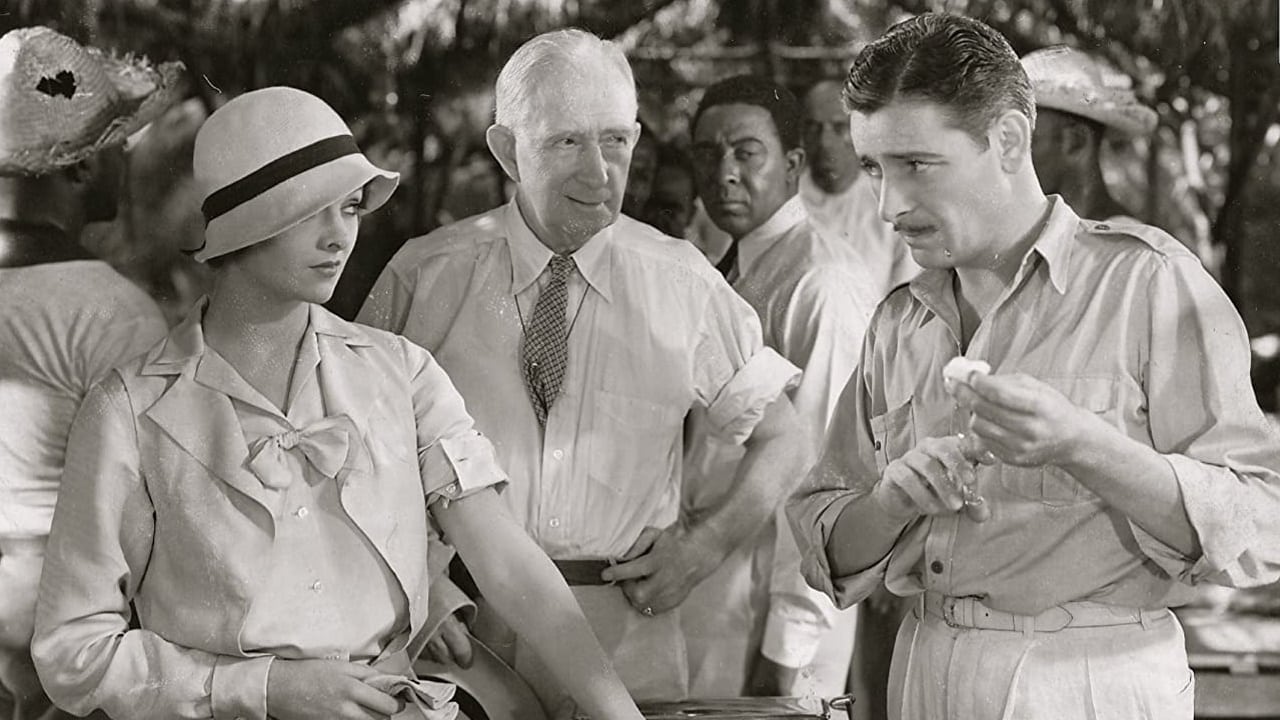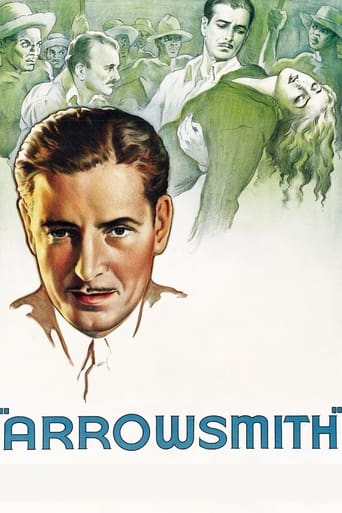

This review is actually more about the novel on which this movie is based than on the movie itself. Normally, that is not the way to review a movie. However, the movie is better than the novel, because there is an absurd event that is described in the novel that the movie wisely, or perhaps fortuitously, left out. For better or worse, I will discuss that event.In the novel, Martin Arrowsmith becomes engaged to a woman named Madeleine. During the summer, Martin goes Canada, where he meet a nurse named Leora, proposes to her, and she accepts. But Martin is still not sure which woman he wants to marry. So, he invites both of them to have lunch with him, and when they arrive, he announces that he is engaged to both of them, and he will let them decide whom he will marry. Madeleine leaves in a huff, but Leora stays and cinches the engagement.When I reached this point in the novel, I threw it aside in disgust. It was one of the stupidest things I had ever read, especially in a well-known novel by an otherwise good author. I had no interest in reading a novel about a man who is that ridiculous. I would say the same about Leora, since any self-respecting woman would do what Madeleine did, which is to get up and leave. But some women are just desperate to get married, and that might explain her willingness to marry Martin, the lunch date notwithstanding. It was the better part of a year before I could bring myself to finish the novel.Years later, the movie turned up on television, and I remember wondering to myself how the movie was going to handle this business with the two women. I was pleased to see that the Madeleine character was not in the movie, thereby eliminating the scene that caused me to despise the novel. As for the rest of the story, Martin is interested in medical research. In testing a new medicine, the standard procedure is to have a control group that gets a placebo to compare with the group that gets the experimental medicine. That way the researchers can tell whether the medicine makes a difference, and whether there are side effects. This is especially emphasized in the novel, where the students are portrayed as being obsessed with controls.When the bubonic plague hits the West Indies, Martin decides to go there and try out his new serum. This requires the use of a control group. But if the serum is effective, this will mean that most of those in the control group will die on account of having only received a placebo. He ends up giving the serum to everyone. Martin's humanity triumphs over his desire to establish the efficacy of the serum.As the movie came to an end, I suddenly realized the point of the lunch date with two fiancées. Madeleine was essentially acting as a control for Leora. By comparing Madeleine's reaction with Leora's, Martin was able to assess Leora's love for him by contrasting it with Madeleine's. The idea was to show just how obsessed Martin was with the need for controls, that he would even try to apply it to love and marriage.That may have been the idea, but it is still absurd. And it is unnecessary. A man will typically have enough experience with women in general to be able to decide whether he should marry one woman in particular. Every woman he has ever dated is a control or sorts. Likewise, a woman will have had enough experience with men to know that if a man she is engaged to turns out to also be engaged to someone else, she should run, not walk, to the nearest exit.It may be that Sidney Howard, the man who wrote the screenplay, left Madeleine out of the movie for the simple reason that most movie versions leave stuff out that was in the novel. But I like to believe that Howard thought the lunch date with the two fiancées was as preposterous as I did, and he mercifully gave it the ax.
... View MoreI haven't actually read "Arrowsmith", but I can guess the major elements based on the film version.At the time of Arrowsmith, typical medical practice was mainly a primitive venture, outside of surgery and bone-mending. Quacks abounded dealing with disease. Pasteur changed all that by discovering the microbial cause of many diseases, later to be affected dramatically by the discovery of penicillin by Fleming.Medical research has always been at somewhat of disadvantage. The only way to be sure that a remedy for a disease works is to test it on human subjects, but it was considered ethically irresponsible to test blindly on humans. That is why so much of medical research depends now on animal experiments before testing on human volunteers."Arrowsmith" explores this conflict at its epicenter: a doctor who crosses one line from practice into research and another line from attempting to cure to blind testing on humans. This leads to tragic personal consequences for the protagonist in the film. Big medical research gets no love here as the film portrays the research foundation as a heartless, results-oriented, publicity-seeking organization. This is a valid point of view in some circumstances, but it dismisses the great difficulty involved in deriving treatments for disease that are both effective and safe.I was disappointed by Ronald Colman's performance as Dr Arrowsmith. He had daring moments in hitting on Helen Hayes in a hospital corridor, but then had a strangely bloodless romantic relationship with her thereafter, even as he's holding her dead body. Even his relationship with his research, beyond working on a serum to cure the disease affecting the cattle in his North Dakota home, seemed very detached. Helen Hayes had a very innocuous role as Arrowsmith's wife, clinging and not offering much in the way of personal life. A E Anson as Prof. Gottlieb played a stereotypical Hollywood scientist, all rigor and no humanity. Myrna Loy had a throwaway role as a Joyce Lanyon, who was to be Arrowsmith's second wife -- but this segment of the novel was dropped, and for some odd reason the final scene with Loy was never cut, although it should have been.
... View MoreWell OK this is NOT a real filmization of Sinclair Lewis' novel. Whether the fault is with the script, the director (John Ford), or the editing, we'll never know. But what is left is still a watchable film with attractive stars. Just don't expect Lewis' novel.Ronald Colman plays the idealistic hero (yes he's too old for the part), married to a down-to-earth woman (Helen Hayes). He battles the hypocrisy of research science funded by a huge foundation just as he battles the "bad science" of small town America, and the third-world conditions that foster epidemics (sounds relevant now).While the plot here is a mish mash, the performances are solid. Colman was a careful actor and seemed content to deliver his crisp diction without delving much into character. Hayes is quite good as the wife. Richard Bennett is excellent and steals the film as the Swedish doctor. Myrna Loy has a small role (that was apparently cut). Also on hand are John Qualen, Beulah Bondi, A.E. Anson as the skeletal Gottlieb, Russell Hopton, Bert Roach, Nora Cecil, Claude King, Adele Watson, and David Landau as the arrogant vet.
... View MoreI can't think of any other actor from the Golden Age of films who was miscast as many times as he was because of the age factor. So it was with RONALD COLMAN who was already forty by the time he played the idealistic young doctor of ARROWSMITH opposite stage star HELEN HAYES.To his credit, he was still playing romantic leads in the '40s (RANDOM HARVEST) when he was in his fifties--and somehow, audiences accepted him regardless of what I call "the age factor". Here, in ARROWSMITH, it's painfully obvious that he was not the best choice for this title role in a trimmed down version of a Sinclair Lewis novel.Surprisingly, the screenplay is by Sidney Howard, who had no trouble adapting Margaret Mitchell's lengthy GONE WITH THE WIND to the screen, but here seems to be obligated to cut out huge sections of the book to get to the main plot line in a hurry. Possibly, because films in 1931 did not run three hours and forty-five minutes.Whatever, the result is a disjointed screenplay that condenses the story in a way that makes motivations and events incoherent at times. Arrowsmith begins his practice as a rather clumsy country doctor in farm country who develops an interest in serum when a neighbor's cattle become infected. When his serum is a success the doctor and his young wife move to New York where he's to work at a big clinic.Soon he neglects his wife while he buries himself in his work to eradicate bacteria. When an outbreak of bubonic plague breaks out--well, you can see where the plot is going.RONALD COLMAN is earnest and already quite distinguished looking as young Arrowsmith and HELEN HAYES suffers nobly as his neglected wife, infected herself through a careless action by her doctor husband. And toward the end of the story, we get a glimpse of the young and seductive MYRNA LOY in a role that is either underwritten or underwent extensive cuts. Cuts seem obvious in the abrupt ending too.Arrowsmith's experiments in the West Indies bring a conclusion to the story. But sad to say, the film is a relic in almost every sense of the word. Hard to picture John Ford at the helm of this project--even though there is a brief glimpse of Ward Bond (one of his favorite players) in an early scene.Summing up: Nothing deep to say about medicine nor does it work as the story of a dedicated doctor who wants to save lives during an epidemic. And it's certainly not Ronald Colman at his best.
... View More